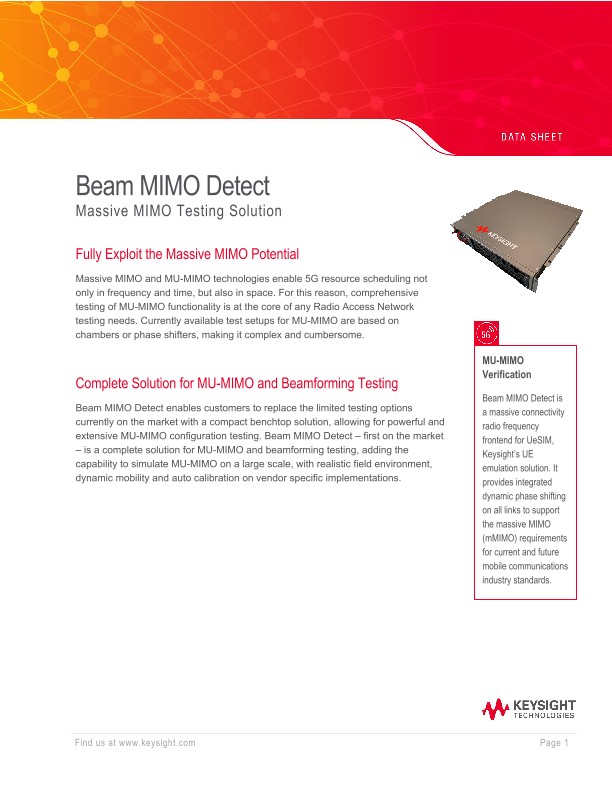
Beam MIMO Detect - Massive MIMO Testing Solution
Data Sheets
Fully Exploit the Massive MIMO Potential
Massive MIMO and MU-MIMO technologies enable 5G resource scheduling not only in frequency and time, but also in space. For this reason, comprehensive testing of MU-MIMO functionality is at the core of any Radio Access Network testing needs. Currently available test setups for MU-MIMO are based on chambers or phase shifters, making it complex and cumbersome.
Complete Solution for MU-MIMO and Beamforming Testing
Beam MIMO Detect enables customers to replace the limited testing options currently on the market with a compact benchtop solution, allowing for powerful and extensive MU-MIMO configuration testing. Beam MIMO Detect – first on the market – is a complete solution for MU-MIMO and beamforming testing, adding the capability to simulate MU-MIMO on a large scale, with realistic field environment, dynamic mobility and auto calibration on vendor specific implementations.
MU-MIMO Verification
Beam MIMO Detect is a massive connectivity radio frequency frontend for UeSIM, Keysight’s UE emulation solution. It provides integrated dynamic phase shifting on all links to support the massive MIMO (mMIMO) requirements for current and future mobile communications industry standards.
Beam MIMO Detect in Tandem with UeSIM
Beam MIMO Detect (BMD) is a massive connectivity RF front-end for UeSIM, Keysight’s UE emulation solution (UEE). Beam MIMO Detect allows to simulate in a lab a population of spatially distributed and moving UEs. It provides integrated dynamic phase shifting on all links to support the Massive MIMO (mMIMO) requirements for current and future mobile communications industry standards.
Up to 64 separate bidirectional radio ports operating in FR1 up to 5GHz TDD bands can be used with different MU-MIMO configurations.
In a usual application scenario, Beam MIMO Detect is configured to be included with UeSIM to implement a full-stack configuration. The beam separation and composition are performed in the digital domain; the digital streams corresponding to the separated beams are routed to UeSIM which emulates the UEs.
The Active Antenna System (AAS) and Beam MIMO Detect are installed in a half size rack. The whole simulation is controlled by UeSIM and is fully integrated with Beam MIMO Detect. This complete end-toend setup, fully reprogrammable, enables massive testing, mobility and ability to reproduce complex test cases.
Beam MIMO Detect at a Glance
Feature |
Description |
Mode Support |
TDD |
Frequency Bandwidth |
Up to 100 MHz |
RF Ports |
Up to 64 RF ports, TX/RX combined Supporting 64T64R, 32T32R, 15T16R, 8T8R active antennas |
Supported Streams |
Up to 16 streams |
Frequency Bands |
FR1 TDD from 2 GHz to 5 GHz |
MU-MIMO Combinations |
Supports up to 4 Independent 4x4 MIMO UE groups or up to 8 2x2 MIMO groups |
Output Power |
14 dBm @2.6 GHz EVM <1% (support for 5G NR 256 QAM) 8 dBm @3.8 GHz EVM 1.2% (support for 5G NR 256 QAM) |
Receiver |
-39 dBm 5G NR signal EVM 0,9% (support for 5G NR 256 QAM) |